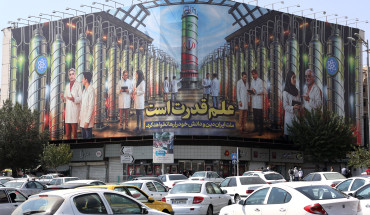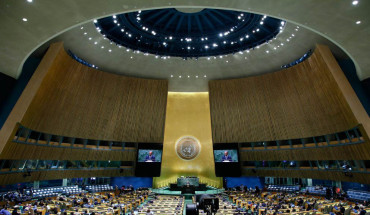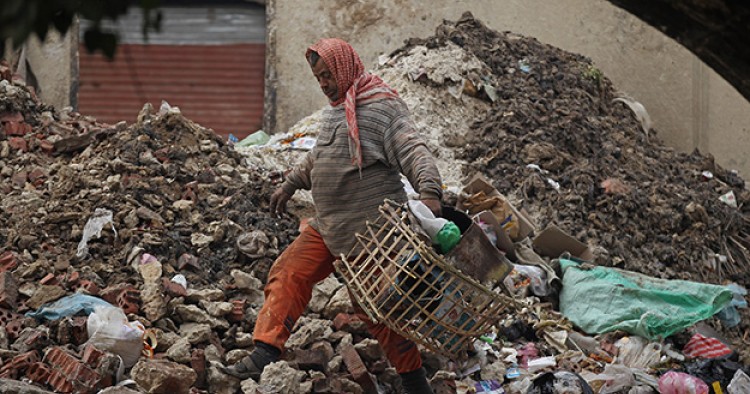Jawad Nabulsi was looking straight at the policeman the moment he was shot in the face. The black-clad officer raised the barrel of his gun, pointed it directly at Nabulsi’s eyes, and pulled the trigger.
It was 11pm on January 28, 2011. The “Friday of Rage,” as protesters called it, would later be labeled the bloodiest day in the revolution that toppled autocrat Hosni Mubarak.
That morning Nabulsi, 32, a young Egyptian entrepreneur and rights activist, had set off from the capital’s western district of Mohandeseen for downtown Cairo. The protesters had battled through water cannons, tear gas, and bullets to cross the Nile’s bridges and take Tahrir Square.
Just before midnight the police launched a full offensive. Nabulsi and a few others stood their ground, knowing that if they lost the square they lost everything.
They would not relinquish Tahrir, but like many revolutionaries Nabulsi would lose one of his eyes. It was this injury that sparked the idea for the Nebny (“we build”) Foundation, which three years on is arguably one of the most successful grassroots NGOs in the country.
During the 18 days of the revolution many medical centers refused to treat protesters, who were being arrested from their hospital beds. Nabulsi himself bled for five hours, going from hospital to hospital across the city, looking for anyone who would take the political risk and sew up his eye. As an upper class Egyptian who went to international schools and grew up in the well-off areas of Heliopolis and Zamalek, he could pay his way in.
Many couldn’t. And so Nebny was born.
It started as a call center to direct injured revolutionaries toward willing medical centers. It also acted as a forum for doctors who wanted to volunteer while documenting the injured, the missing, and the dead. Nabulsi broke curfew to sneak into Tahrir Square and hand out pamphlets promoting the hotline number. He called into Egypt’s myriad television shows to spread the word.
In the aftermath of the 18-day uprising Nebny faciliated the treatment of 2,260 revolutionaries, many of whom, like Nabulsi, had been shot in the eyes.

Jawad Nabulsi
Before the revolution, Cairo-born Nabulsi, a successful business student who graduated from Canada’s Arcadia University in 2006, began his career launching start-ups. He founded a consulting firm and later three Cairo restaurants.
He plugged into revolutionary circles when he joined the protests of the Kefaya opposition movement on his return to Egypt in 2007. Launched by 500 Egyptian intellectuals from across the ideological spectrum, Kefaya was united in one goal: to topple Mubarak.
Kefaya coordinator Abdel-Wahab el-Messiri, a prominent Egyptian scholar who at various points was a communist and a member of the Muslim Brotherhood, became his mentor.
At that time Egypt was witnessing a shift in which the youth, many of them second or third generation activists, took up the mantle of dissent and used new media such as blogs and the social networking sites Facebook and Twitter to organize and build the opposition.
Nabulsi’s contemporaries were figures like Alexandrian engineer Ahmed Maher, 33, who founded the April 6 youth movement in 2008 to support strikes in Egypt’s industrial heartland Mahalla. Another, computer programmer and fellow protestor Alaa Abd el-Fattah, 32, won international awards and jail time for his anti-government blog Manalaa. Both young men are now in prison on charges ranging from participating in “illegal protests” to attempting to destabilize the country.
Back in 2006 Nabulsi set up a “Keep Egypt Clean” Facebook group, which called for a “green revolution” in a country where corruption was so entrenched that nothing properly functioned, even waste collection and penalties for littering. By January 2011, it had gathered over 80,000 members. During the revolution, Nabulsi mobilized the page’s followers to leave their computers and come down to Tahrir.
While Maher and Abd el-Fattah have become household names for their ongoing political activism, Nabulsi took a different approach and kept below the radar after the toppling of Mubarak. He turned down the post-revolution offer of becoming the Minister of Youth.
He used his background in business to focus on humanitarian work and evolve the Nebny Foundation into a project that focuses on building sustainable models for a better future.
Never without his signature eye patch, the well-dressed fluent English language speaker looks more like a businessman in a boardroom than an aid worker who runs projects out of Cairo's slums.
“My point is to create models to replicate them across Egypt [as well as] across the world,” he told me by phone from Stanford University in the United States, where is he currently studying.
He started working in the rural areas of Upper Egypt but eventually moved into an apartment in southeast Cairo’s Manshiyat Naser, which is nestled into the cliffs of Mokattam Hill and houses Egypt’s largest informal settlement, “Garbage City.”
Hundreds of thousands of Cairo’s poorest live in the area, many of them Coptic Christians and garbage collectors who sort through some 9,000 tons of the capital’s waste every day to make a living.
The plan was to make an exemplary street of 70 houses to develop the slum area.
“But we started discovering [more profound] problems,” Nabulsi says. “The main issue was education; between 40 and 70 percent of kids in school could not read or write. There was Hepatitis C, malnutrition problems, and unemployment rates as high as 40 percent.”
In August 2012, Nebny secured permission from the authorities to build a community center that would provide literacy classes, medical assistance, and loans and business advice for the community’s struggling craftsmen. It is run by 400 volunteers, the majority of whom are women, and looks after a mix of Muslims and Christians.
The project was crowd-funded from within Egypt, which is rare in a country where NGOs have to rely on foreign financial assistance that is gradually drying up. Its flagship program, “Educate a Child,” links donors with specific children, who are taught to read and write in just two months.
The numbers speak of success: To date the foundation has served 100,000 people, educated 1,200 students, and distributed some $7,000 in microloans. In 2013, it was chosen to join the World Bank staff donation campaign, beating some 40,000 NGOs throughout the Middle East.
But it is now under threat.
At night the volunteers sleep on the floor of the community center as a human shield against an impending police raid.
The local district head, Gamal Mohamed Mohey, wants to clear the Nebny Foundation in order to build a post office. Mohey says the center has encroached on state-owned land and claims to have official letters from the Ministry of Social Solidarity stating that it “has not done any beneficial activity for the neighborhood.”
The local community vehemently disagrees and is staging protests. Popular television satirist Bassem Youssef has joined in the media condemnation of the government’s decision.
“If they try to forcibly kick us out, I think it would be a big disaster,” Nabulsi says.
This is not the first time the government has attempted to intervene in Nabulsi’s work post-revolution. Under former Islamist president Mohamed Morsi, Nabulsi says he was barred from opening a medical center as he refused to put the logo of the Muslim Brotherhood and its ruling Freedom and Justice Party on the building.
“I didn’t have the proper hat or political cover,” he says.
It is a difficult time to work in Nabulsi’s field, but he is determined to keep fighting. Since the ouster of Morsi last July, over 21,000 people have been arrested, including protesters, journalists, and human rights workers, according to local monitoring group Wiki Thawra. Many more have fled.
“We still have eight years until this country starts heading in the right direction… we can’t expect the deep state to be out in just three years,” Nabulsi concludes. “We won’t stop. No matter what happens we are going to keep going.”
The Middle East Institute (MEI) is an independent, non-partisan, non-for-profit, educational organization. It does not engage in advocacy and its scholars’ opinions are their own. MEI welcomes financial donations, but retains sole editorial control over its work and its publications reflect only the authors’ views. For a listing of MEI donors, please click here.













